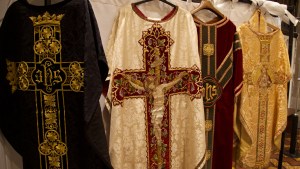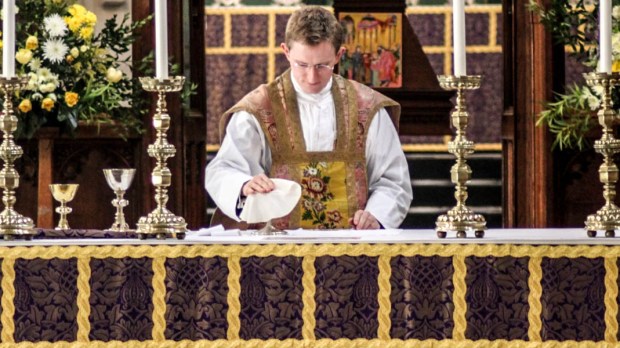Throughout the Church’s liturgical year, priests wear several different color vestments. The colors are not arbitrary, but reflect a deeper meaning that is meant to point us to a specific spiritual theme.
Since ancient times, whenever a priest celebrated the sacrifice of the Mass he would put on a large poncho-like garment called a casula (chasuble) that covered his ordinary clothing. This vestment developed from the ordinary Roman attire of a farmer, who wore the large poncho to protect him from the elements. By the 8th century the chasuble was reserved for clergy members and a few centuries later specific colors were in use.
Initially white was the only liturgical color. By the 4th century different colors began being added added. It wasn’t until the 12th century that the present-day colors were finalized.
The colors were developed to highlight different spiritual truths according to the day in the Church’s calendar. That way, when someone attended Mass they could immediately recognize the color and associate it with the season or day that was being celebrated. It led the people into a deeper understanding of the faith and reinforced whatever spiritual lesson that needed to be taught.
Below is a list of the basic colors of the liturgical year, as well as some additional colors that were used in the history of the Church.
White represents holiness, purity, cleanliness, and righteousness. White is worn during the joyful seasons of Easter and Christmas; on feasts of Our Lord not connected to his Passion and death; on feasts of the Blessed Virgin Mary; and on feasts of angels and saints who did not shed their blood for the Christian faith.
Red is the color of blood and symbolizes love, fire, passion, and the blood of sacrifice. Red is worn on Palm Sunday, Good Friday, any day related to Jesus’ Passion, on Pentecost and on the feast days of those who died for the faith (martyrs).
Green is a color associated with spring and used to represent new life, regeneration, and hope. It is now the color of Ordinary time, while the Orthodox use it during Pentecost.
Violet represents penance and sorrow for sin. It is worn during Advent and Lent, as well as other occasions connected to penance or reparation.
Black is a color that traditionally symbolizes death and may be worn at funeral Masses or All Souls Day.
Rose is a color resplendent with joy, worn on only two days of the Church’s liturgical year. Rose is worn on the Third Sunday of Advent and the Fourth Sunday of Lent. Rose vestments signal the end of the penitential season and announce the upcoming celebration of Christmas or Easter.
Gold vestments are sometimes worn at Masses that denote a special day of celebration. This could be at Easter, Christmas or another day of great solemnity. It usually replaces white in the liturgical spectrum.
A few other vestments in the history of the Church
Silver is similar to gold in that it is a more solemn version of white.
Blue vestments (meaning the dominant color is blue) are worn in honor of the Blessed Virgin Mary and are only permitted in certain places.
Historically the Church has also chosen different shades of each color for different feast days. In Byzantine and Orthodox churches they follow an ancient text that simply divides all colors into general, dark and bright. This allows for a great variation among the many different rites of the East.
Everything has a purpose in the liturgy and is designed to lead the people into a deeper relationship with Christ.

Read more:
Why is my priest wearing pink?

Read more:
Why do priests wear a chasuble at Mass? And what’s a chasuble?

